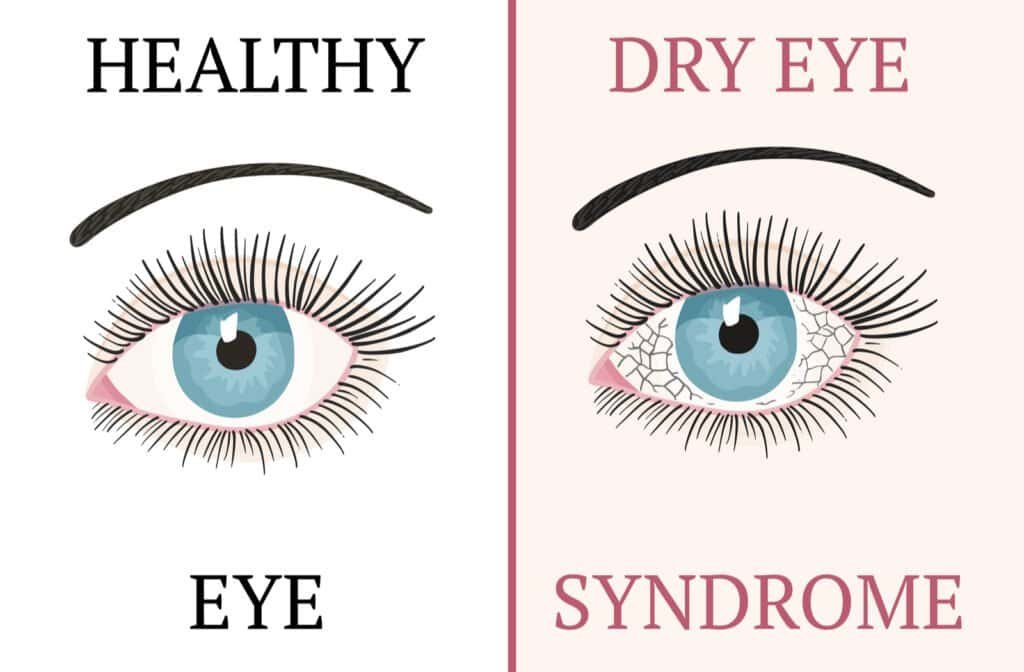Dry eye, also known as keratoconjunctivitis sicca, is a frequent ocular condition that results from inadequate lubrication and moisture on the surface of the eye. It arises due to either a deficiency in tear production by the lacrimal glands or an increased rate of tear evaporation. Symptoms usually include irritation, discomfort, redness, and burning sensations, among others. Additionally, dry eye can lead to decreased vision quality and complications such as corneal damage or even ulcers if left untreated for prolonged periods of time. To minimize symptoms, treatments involve increasing moisture levels in the eyes through artificial tears or more complex approaches such as using punctal plugs to reduce tear evaporation or autologous serum tears for severe cases.
Furthermore, lifestyle factors such as avoiding smoking, limiting eye strain from computer screens, and wearing protective eyewear can help prevent dry eyes from worsening. As the dry eye is a highly prevalent condition with potential long-term consequences, it’s important to seek medical advice if one experiences any signs or symptoms associated with this condition.
Recommended Solutions for Dry Eye
To alleviate the discomfort and promote eye health, several solutions can be implemented. Let’s explore the most effective remedies for combating dry eye syndrome.
- Artificial Tears and Lubricating Eye Drops
Artificial tears and lubricating eye drops are commonly used as a primary treatment for dry eye, a condition that is characterized by insufficient tear production or an imbalance in the components of the tear film. In order to soothe the discomfort caused by dryness and irritation, these over-the-counter solutions work to replenish moisture on the ocular surface. Artificial tears closely resemble natural tears, containing components such as electrolytes and proteins found in healthy tear fluid. They are designed to interact with the eye’s tissues to mimic the composition of natural tears while providing relief from discomfort.
In addition to providing temporary relief, lubricating eye drops may also help maintain a healthy tear film and reduce inflammation around the eyes. While these products can offer quick symptom relief, it is important to consult with an ophthalmologist if symptoms persist or worsen for proper diagnosis and treatment.
- Lifestyle Modifications
Lifestyle modifications are important for managing dry eye symptoms and overall ocular health. Incorporating certain changes into day-to-day habits can make a big difference in alleviating dry eye discomfort and achieving long-term relief. Avoiding smoke-filled environments, reducing screen time, eating a diet rich in fatty acids such as omega-3s, drinking plenty of fluids to stay hydrated, and taking regular breaks to avoid over-exerting the eyes are all helpful measures to reduce dry eye symptoms.
Additionally, blinking more frequently can help keep the eyes lubricated and comfortable while making sure to get enough sleep at night helps maintain adequate tear production. Lastly, wearing sunglasses when outdoors can protect the eyes from harmful UV rays which can contribute to dry eye discomfort. These simple lifestyle modifications can go a long way toward keeping your eyes healthy and your vision clear.
- Nutrition and Hydration
When it comes to promoting ocular well-being, proper nutrition and hydration are paramount. To ensure your eyes receive the optimal levels of vitamins and minerals they need, consider incorporating nutrient-dense foods like salmon, walnuts, and flaxseeds into your diet. Omega-3 fatty acids found in these items can provide significant benefits for eye health. Staying adequately hydrated is also key. Be sure to drink enough water throughout the day to keep your eyes functioning at their best. Furthermore, dietary supplements such as lutein and zeaxanthin may help protect your vision from damaging environmental stressors. Taking all these dietary considerations into account can help you maintain clear and sharp eyesight for years to come.
- Warm Compresses and Lid Hygiene
Combatting dry eye can be achieved through the judicious use of warm compresses and diligent lid hygiene. Warm compresses serve to increase tear production by stimulating the oil glands. These oils enable the eyes to effectively retain moisture, thus avoiding undesirable dryness. To further bolster one’s defense against dry eye, proper lid hygiene should be implemented. This entails clearing away any dirt or obstruction from the oil glands, keeping them open and functioning optimally. By following this two-fold approach, individuals can minimize many of the triggers causing dry eye and maintain an optimal level of ocular comfort. To summarise, warm compresses and lid hygiene are essential steps toward achieving successful dry eye management.
In the pursuit of combating dry eye and ensuring optimal ocular health, implementing the recommended solutions can bring substantial relief. By incorporating artificial tears, making lifestyle modifications, focusing on nutrition and hydration, practicing warm compresses and lid hygiene, and seeking professional guidance when necessary, individuals can effectively manage dry eye symptoms and improve their overall well-being. In addition, for a comprehensive resource on dry eye treatments and specialists, be sure to explore the extensive listings and information available at the Dry Eye Directory.
Do check out: The Northern Lights: When can you see it?


